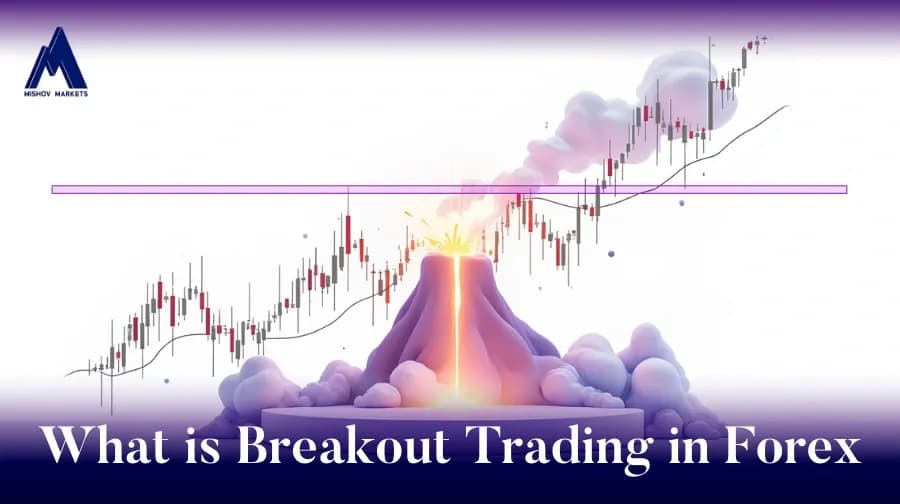What is Breakout Trading in Forex

Breakout trading in forex where every tick means profit or loss in the financial world and everything moves so fast is a unique path for your trading journey. Breakout trading stands out as a thrilling way to generate revenue on market momentum.
What is breakout trading anyway? Let’s imagine a price surging past the defined support or resistance levels and unlocking the potential for significant gains for astute traders. This phenomenon not only attracts trend traders but also opens the door to exciting opportunities for those ready to seize the moment. In this article, you will read about the intricacies of breakout trading strategy—explore how it works, its advantages, and potential drawbacks.
What is Breakout Trading in Forex?
A breakout happens when the price moves outside a specific range that it has been confined to. It can break either from the resistance levels or the support levels while both carry different meanings. Price breaking through resistance signals buying pressure and conversely, the price breaking through support suggests selling pressure. Traders set entry points just above the resistance levels or below the support level to catch the early wave of the trend.
Similarly, breakout trading in forex refers to when traders want to take advantage of price movements that break through defined levels of support or resistance. Prices move between these two levels in a sideways or range-bound market but they eventually break out, moving either upwards or downwards which is a sign of volatility in the market.
For instance, one of the economic announcements that impact the prices of financial markets is the release of U.S. non-farm payroll data, which causes sudden volatility in the forex market. If a currency pair like EUR/USD has been moving within a tight range before the announcement, a strong deviation from the data can lead to a breakout, with the price moving past the resistance or support levels, traders who had placed orders based on this breakout can capitalize easily on this trend.
Types of Breakout Trading in Forex?
Generally, we could say in Forex there are three types of breakout trading. Let’s take a look at each separately:
-
Continuation Breakout: This type occurs when the market is already moving in a certain direction either up or down. A pause known as a Base occurs, but then the trend continues going in the same direction.
-
Reversal Breakout: This one happens when a certain trend consolidates but then changes direction completely moving to the other direction signaling a potential reversal. This is riskier but can offer higher reward-to-risk ratios.
-
False Breakout: This happens when the price moves past the confined resistance or support levels but fails to continue the same way.
How to Use a Breakout Entry in Your Trading?
Traders who want to use this strategy must be precise and patient because they often have to monitor price charts to spot consolidation, where the market appears to be gathering momentum for a future move. To make sure the breakout is valid, traders set an entry point slightly beyond the resistance or support level. It’s important for traders to wait and confirm the breakouts because the price can break temporarily only to reverse back quickly.
To make things clearer, we can look at this example, imagine GBP/USD is trading in a tight range between 1.3800 and 1.3900, and a trader using a breakout strategy sets an entry order to go long (buy) at 1.3910, just above resistance, or go short (sell) at 1.3790, just below support. This allows the trade to be triggered only if the market shows genuine strength in the breakout direction.
Does Breakout Trading Work?
Shortly, yes. Breakout trading can be profitable, especially in volatile markets. however, like any other trading strategy comes with its own set of risks, the profitability of strategy depends on how appropriately it’s applied, the trader’s approach, and knowledge along the experience.
Here is a great example of a successful breakout trading:
This notable event occurred with Tesla Inc. (TSLA ) in early 2020. It showed a strong performance in 2019, and then the stocks entered a Base phase that was around the $450 to $500 range. In late January 2020, the price broke from the range and moved above the $500 resistance level, accompanied by significant trading volume. This was a strong signal for buying interest. The breakout persisted and reached over $900 by late January 2021, which is nearly doubling its previous price.
“Tesla Inc. (TSLA) - Yahoo Finance”
How to Confirm Breakout Trading?
Confirmation of a breakout cannot be expressed enough, and it’s important to avoid false breakouts so that risks are mitigated. Several methods can be used some common ones are below:
-
High trading volume accompanying a break can be a sign of validation. Volume confirms the strength of a breakout, more volume means more traders are committing to the move.
-
After a breakout, prices sometimes go back to where they were but if they don’t reset and hold moving toward the resistance or support level then it’s a confirmation of the breakout.
-
Traders usually use indicators to confirm a trend. For example, a breakout with a rise in MACD histogram or Volume indicator showing an increase in volume in an uptrend can signal that the momentum is strong.
Is Breakout Trading Profitable?
Breakout trading has the potential to be profitable, but its success depends on several factors. Market conditions, strategy implementation, and a trader’s approach, along with their knowledge, all impact the profitability of this strategy. For example, the forex market tends to experience significant volatility around geopolitical events or when major economic announcements are made because they often lead to profitable breakouts. In 2022, when the uncertainties were heightened because of the Ukraine conflicts, currency pairs like USD/JPY and EUR/USD experienced significant breakouts as traders reacted to shifting geopolitical and economic conditions. Traders who applied the breakout strategy at the right time were able to make profitable trades. However, the breakout strategy is not foolproof, so traders must be careful and have the ability to filter out false breakouts along with sound risk management practices.
What is the Best Indicator for the Breakout Strategy?
Several indicators can assist traders in identifying and confirming breakouts, here are some of the popular ones:
Relative Strength Index (RSI): This indicator helps to confirm whether the market is overbought or oversold and shows them numbers between 1-100. A reading above 70 would mean that the asset is a potential selling opportunity near resistance and readings below 30 suggest a potential buying opportunity near support.
Moving Averages (MA): Whether you are using Simple Moving Averages (SMA) or Exponential Moving Averages (EMA), both can indicate trend direction. A breakout above a moving average line, especially the 50 or 200 period moving average can be a confirmation as well.
Volume: As mentioned earlier, volume is critical. High volume during a breakout suggests the move has the strength to change direction and is less likely to reserve.
What is the Best Time Frame to Trade Breakouts?
There’s no such thing as the best time frame because the best time frame depends on the trading style of each individual. For example, day traders usually prefer shorter time frames like the 5-minute or 15-minute charts than swing traders who try to focus on the 1-hour or 4-hour charts to catch larger moves over several days.
For long-term traders, daily or weekly time frames may be ideal and some might even prefer larger time frames because of the broader view they can get. This way they can capture major breakouts that may last for weeks or even months.
If traders want to find out exactly which time frames suit them the best, the right strategy would be to practice and analyze all 3 time frames on a demo account and select the best one that works for them.
What are the Pros And Cons of the Breakout Trading Strategy?
Like any other strategy in trading, breakout trading also has its set of advantages and potential drawbacks. Let’s first look at some advantages:
-
High-Profit Potential: When implemented appropriately in suitable market conditions can lead to significant gains.
-
Easier to Identify: Since it’s easier to spot the resistance and support levels, a breakout strategy becomes easily accessible for traders at all levels.
-
Adaptable to Different Markets: traders can use this strategy in various markets including forex, stocks, and commodities.
Some of the common potential drawbacks are:
-
Fake breakouts: The biggest risk in the breakout strategy could be fake breakouts, where the price breaks but then reverses back.
-
Volatile Markets Risk: Sometimes the unpredictability of the market can cause a swing and make managing trades difficult.
-
Requires Patience: the consolidation or distribution period can sometimes take longer than expected and waiting for the breakout to happen can become unbearable.








